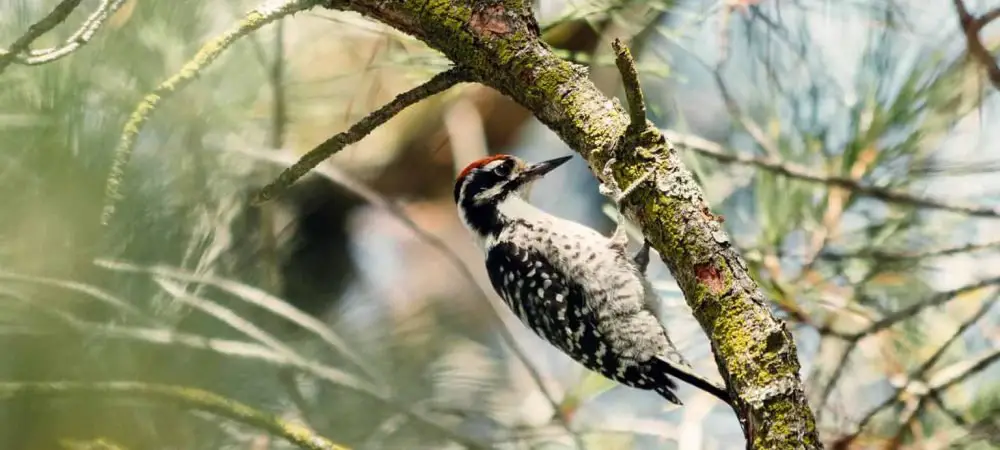
In Arizona, it is possible to spot 14 different species of woodpecker. These are:
- Gila Woodpecker
- Ladder-Backed Woodpecker
- Northern Flicker
- Acorn Woodpecker
- Hairy Woodpecker
- Red-Naped Sapsucker
- Arizona Woodpecker
- Lewis’s Woodpecker
- Downy Woodpecker
- American Three-Toed Woodpecker
- Red-Headed Woodpecker
- Williamson’s Sapsucker
- Yellow-Bellied Sapsucker
- Red-Breasted Sapsucker
Want to learn more? Take a look at the North American Guide to Woodpeckers
Arizona is a southwestern state in the United States. This state is famed for the Grand Canyon, and the mile-deep chasm carved by the Colorado River.
It is also known for its plethora of natural sites such as Flagstaff, Saguaro National Park, and the Sonoran Desert landscape.
An interesting characteristic to note about Arizona is that it has multiple climates: semiarid, arid, and humid.
These varying climates make Arizona an appealing home to all kinds of wildlife. In fact, Arizona is known as one of the most diverse woodpecker states.
Since Arizona is home to 31 state parks, it comes as no surprise that Arizona is home to an expansive 14 species of woodpeckers!
You are most likely to spot the Gila Woodpecker, while you are least likely to see the Red-Breasted Woodpecker. Read below to understand the dynamic qualities for each species!
Take a look at our article on How to Attract Woodpeckers?
What Woodpeckers can be seen in Arizona?
Table of Contents
1. Downy Woodpecker
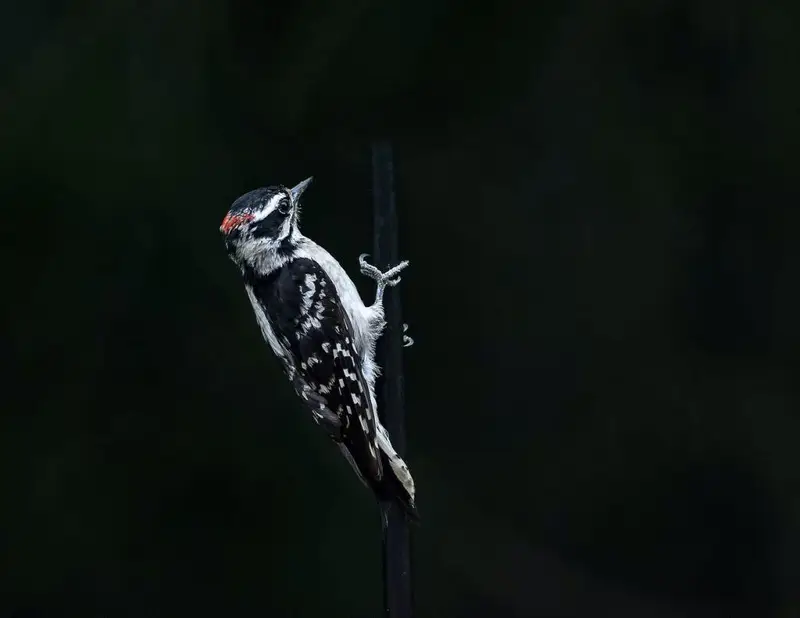
Wingspan
3.27 to 4.13 inches
Weight
0.75 to 1 ounce
Life Expectancy
12 Years
Diet
Insects & Non-insect arthropods
Downy Woodpeckers are a very small species of bird. They are black and white, similar to Hairy Woodpeckers.
However, some distinguishing factors are black markings on their white tails, their and short bills. Take note that Downy Woodpeckers in the western states tend to be darker overall, with less white on their wings compared to birds from eastern states.
You can find these birds nesting in the cavities of large trees, or visiting feeders in suburban areas.
During the spring and summer, Downy Woodpeckers are known to be very noisy due to their shrill whinnying call and their repetitive drumming on trees.
You can usually spot these birds hitching around tree limbs and trunks searching for food.
2. Yellow-bellied Sapsucker
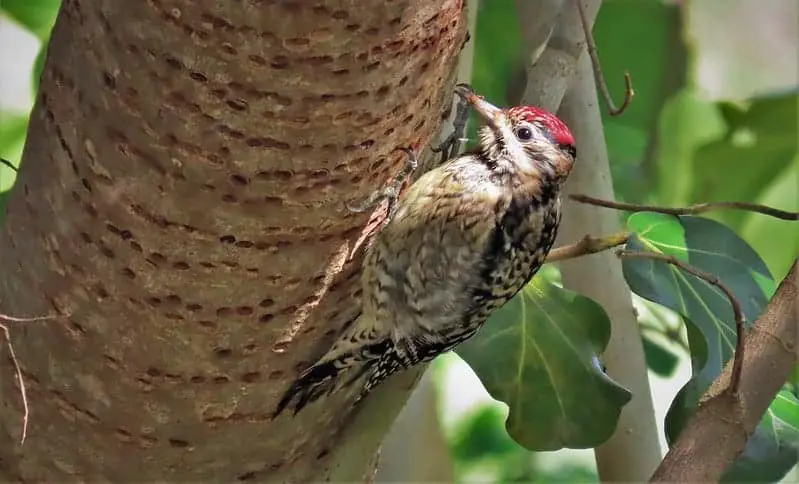
Wingspan
13 to 16 inches
Weight
1.5 to 1.9 ounces
Life Expectancy
7 years
Diet
Tree sap, insects & fruit
Yellow-Bellied Sapsuckers are medium-sized birds and have a striking wing stripe on their shoulders.
Mature males have red feathers on their foreheads and throats while mature females have white throats. They are famed, and named for their pale, yellow bellies.
However, juveniles are generally brown. Yellow-bellied Sapsuckers tend to take habitat in hardwood and conifer forests at high elevations.
They nest in the groves of small trees like aspens. Sometimes these sapsuckers can be seen in residential areas at bird feeders. These birds are monogamous and take long-term mates every year.
They tend to be more quiet in the winter, becoming more noisy in spring, with cat-like calls and drumming during mating season.
3. Northern Flicker
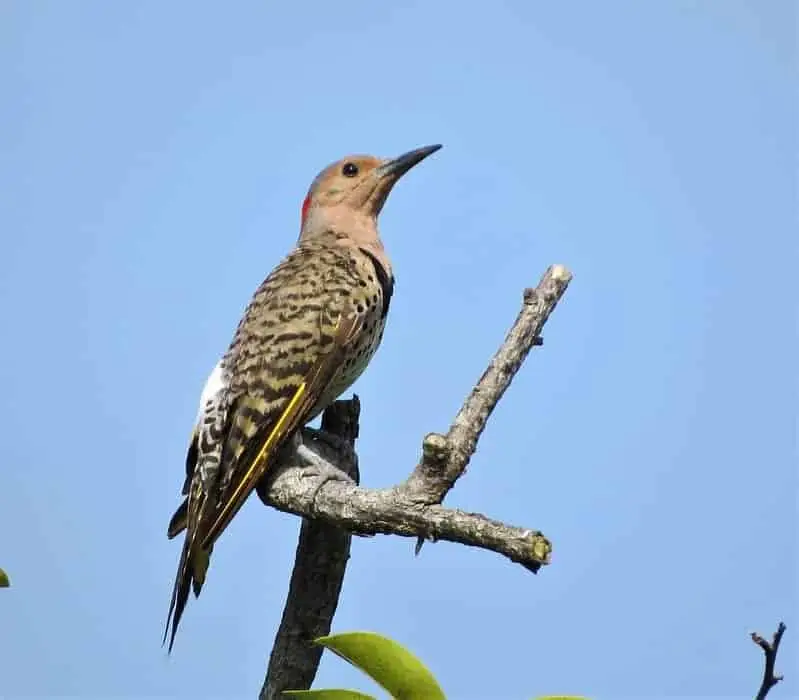
Wingspan
21.3 inches
Weight
6 ounces
Life Expectancy
9 Years
Diet
Insects, seeds, nuts & fruit
Northern Flickers are a large species of woodpecker. Flickers are the largest woodpecker species in the Central Arizona region.
They typically have brown feathers with some black barring on their backs. Additionally, they feature black spots on their bellies.
Males however, have a large bright red stripe on their cheek. They are most recognized in flight, as their white feathers near their rumps are clearly displayed.
Their wings typically have red or yellow feathers with a black crescent-like shape just above their breast.
They can be seen year-round in Arizona in several oak, juniper, coniferous, and deciduous trees, nesting in their cavities. They tend to breed from early spring to late summer in Arizona.
You can hear them as they give off their rhythmic ‘wake-up’ call. This species is the only woodpecker that spends a lot of time down on the ground foraging for insects–and they can be readily seen in the spring and summer month
4. Lewis's Woodpecker
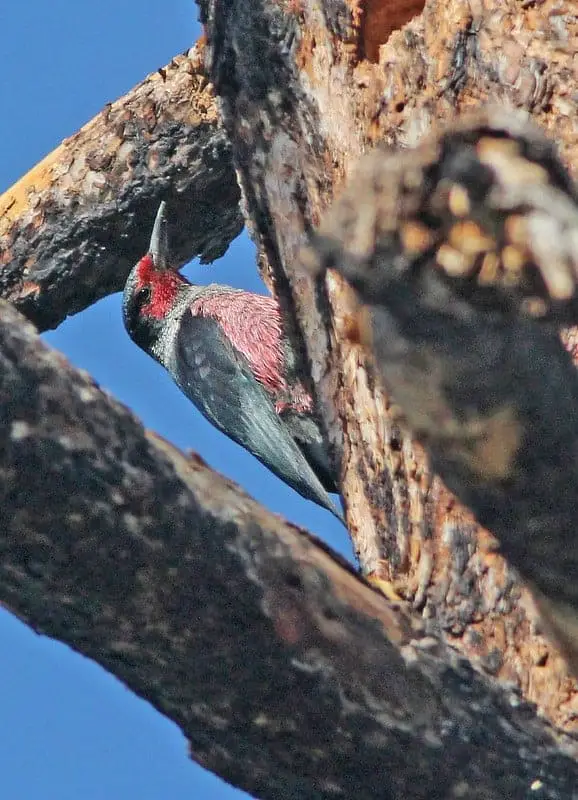
Wingspan
11 inches
Weight
4 ounces
Life Expectancy
4-11 Years
Diet
Insects & Nuts
Lewis’s Woodpeckers are a larger species of woodpecker, named for Meriwether Lewis who discovered the species.
These woodpeckers have stunningly unique color patterns. They have red faces, dark green backs, gray necks, with pink on their bellies.
Immature woodpeckers appear more brown and dull than the adults in this species. Lewis’s Woodpeckers are recognized as odd birds due to their characteristics that are unlike other woodpeckers.
They fly in a way that resembles a crow while they catch insects in mid-air–which is unlike the usual woodpecker’s flying and foraging behavior.
Lewis’s Woodpeckers breed in northern regions of Arizona at high elevations and you can hear males making a harsh ‘churr’ sound during courtship.
You can find these woodpeckers in open woodlands in groups, and even near human residences, using telephone poles to stash food.
5. Red-headed Woodpecker
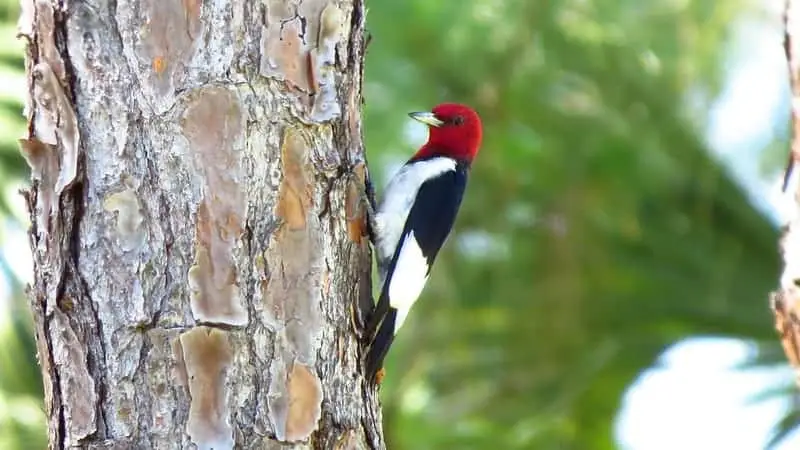
Wingspan
16 inches
Weight
2.5 ounces
Life Expectancy
9 Years
Diet
Insects & Berries
Red-Headed Woodpeckers are medium sized with white feathers and dark wings, but famed for their red heads.
These birds take habitat in a variety of areas like open woodlands, forests, orchards, oaks, cottonwoods, fields or places with little vegetation, and even residential areas.
They like to nest in dead trees with easy access to ground foraging. Interestingly, Red-Headed Woodpeckers are not known to excavate holes for insects.
They are often seen using the fly and catch method to catch insects in the air. They are also known to breed from early spring to late summer.
Be aware that Red-Headed Woodpeckers are recognized for being territorial in which both sexes guard their home against predators and other birds who may come for their food.
6. American Three-Toed Woodpecker
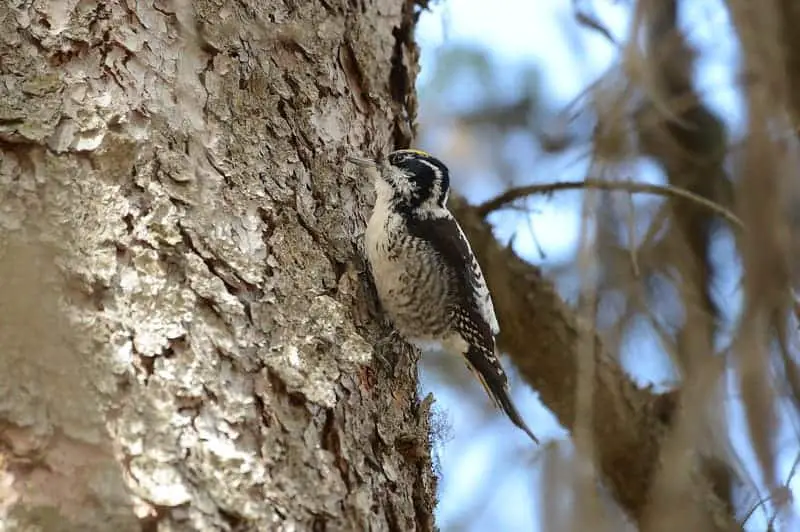
Wingspan
15 inches
Weight
2 ounces
Life Expectancy
6 Years
Diet
Beetle Larvae, insects & fruit
American Three-Toed Woodpeckers are medium sized and dark with barred flanks and faint white spots on their wings and backs.
Their faces are black with white stripes above and below their eyes. They also tend to have white spotting on their foreheads. Adult males display a brilliant yellow patch on their heads.
These birds are quite solitary and usually uncommon in forests. They prefer to take habitat in disturbed areas such as burned areas with dead trees.
You’ll likely see these Three-Toed Woodpeckers in burned forests taking off the bark of trees foraging for larvae and other food for their young. You can most often identify these birds by a soft ‘pweek’ sound and a faint drumming sound.
7. Black-backed Woodpecker
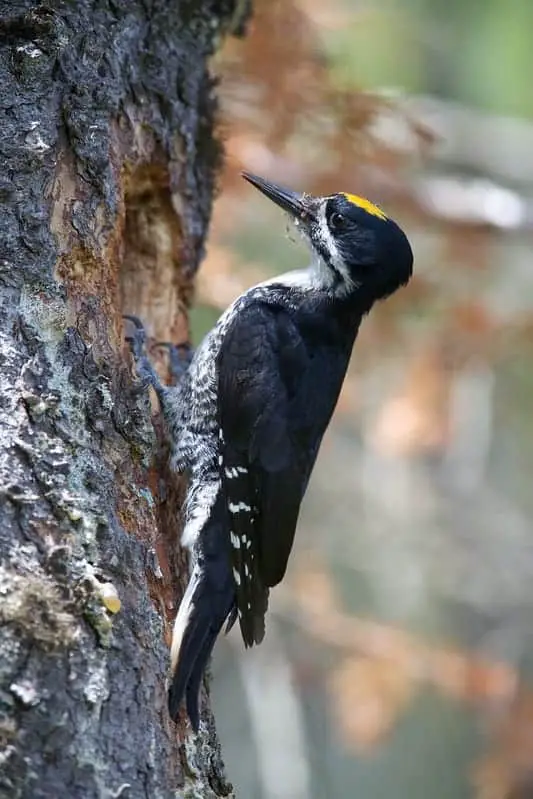
Wingspan
16 inches
Weight
2.5 ounces
Life Expectancy
8 Years
Diet
Wood-boring Beatles, fruit & nuts
Black-backed Woodpeckers are medium-sized woodpeckers, and as their name suggests, they have dark-colored feathers.
Their backs are glossy and have light white markings on their flight feathers.
Their heads are also black and they have a white throat. These species are a bit more uncommon than most others.
They live in coniferous forests among dead trees or burned areas. What sets them apart from other woodpeckers is how they flake bark off of trees similar to the American Three-Toed Woodpecker.
Black-backs have a short call with a distinctive clicking tone. You’re unlikely to find this unique species at bird feeders, but most likely in forested areas on tree trunks in Alaska – it may be difficult however, as they prefer to be inconspicuous.
8. Williamson's Sapsucker
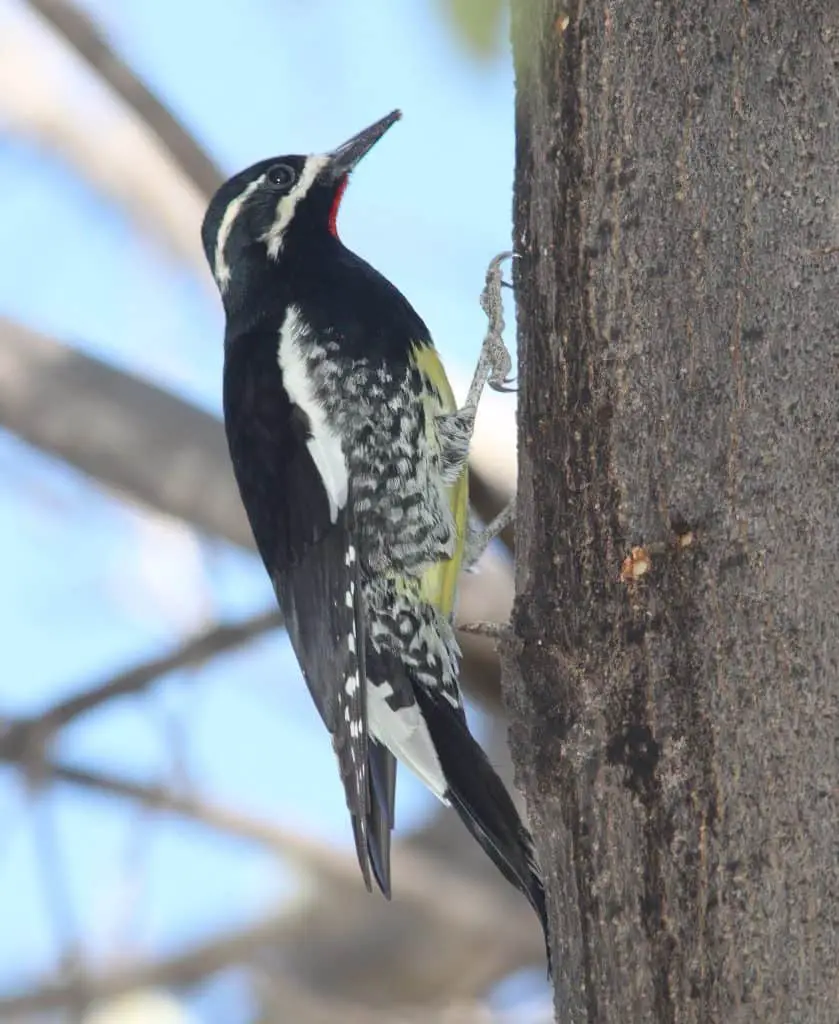
Wingspan
13.4-15.8 inches
Weight
44-55 g
Life Expectancy
7 Years
Diet
Sap
A Williamson’s Sapsucker is a medium sized bird recognized for its bold patterns.
The males are mostly black with bold white colored feathers on their wings. Two white stripes also adorn their faces.
They have red throats and yellow bellies. Females on the other hand, have brown heads and detailed black and white barring on their backs and wings with a dark breast, and yellow belly.
These sapsuckers nest in open coniferous and mixed woodlands in mountains of western states. They particularly like to live in mature forests that have pine, larch, fir, and aspen.
They live in similar habitats during both the summer and winter months. You can easily identify this bird by their high, nasal ‘chyaah’ sounding call.
9. Red-Naped Sapsucker
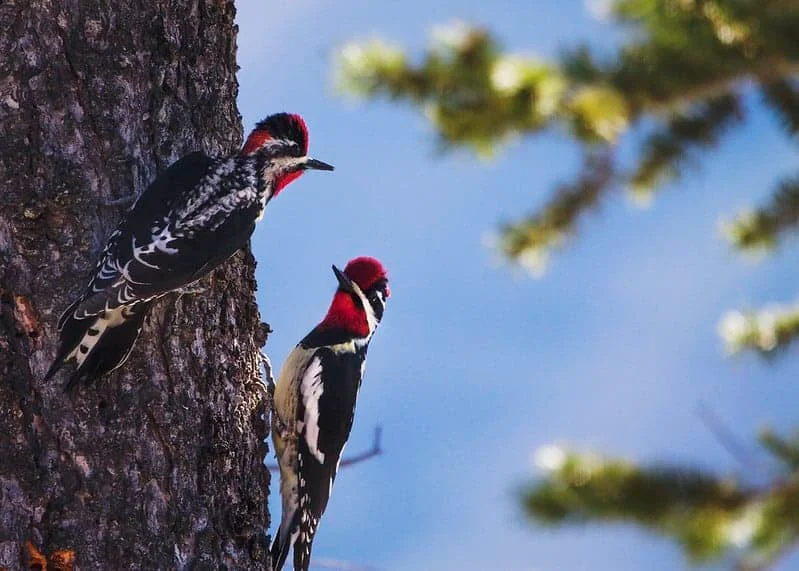
Wingspan
16.1-16.9 inches
Weight
32-66 g
Life Expectancy
5 Years
Diet
Insects
Red-Naped Sapsuckers are medium sized woodpeckers with brilliant, white slashes on their wings that distinguish them from other woodpeckers.
These sapsuckers have bold black, white, and red face patterns with white feathers on their backs.
Though they have suffered a slight loss in habitat, they tend to breed in montane forests, usually in aspen trees or willow trees.
You can find these birds drilling holes into tree trunks, looking for sap and insects–while they nest in the cavities of the trees.
A unique characteristic of this bird includes its mating ritual. Their courtship displays include pointing up their bills to feature their throat patch, followed by tapping at the nesting site.
You can most likely see these birds during breeding season in the late spring and summer months.
10. Acorn Woodpecker
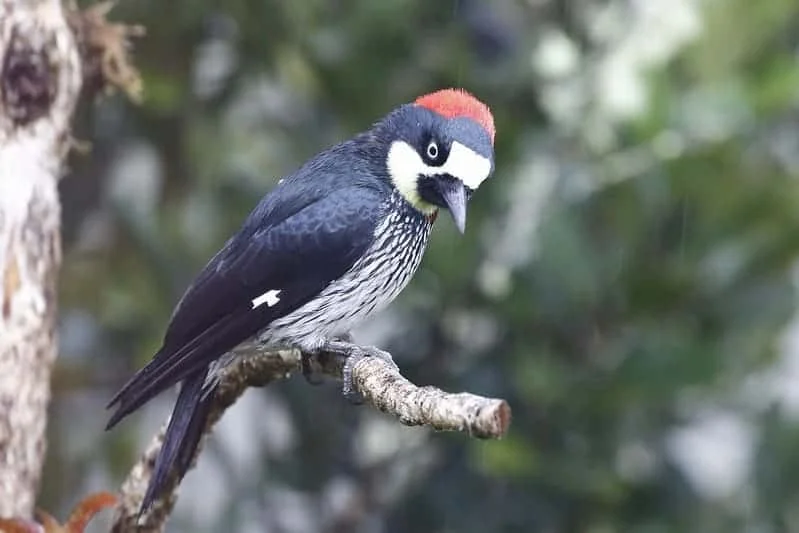
Wingspan
13.8-16.9 in
Weight
3.0 oz
Life Expectancy
10 Years
Diet
Acorns and Insects
An Acorn Woodpecker is medium in size and is praised for its beautifully unique face pattern and red crown.
This species is particularly identifiable because of its yellow forehead, throat, and its pale eyes.
These woodpeckers like to live in mixed oak-conifer forests while they nest in tree cavities. They tend to live in large groups where they live up to their name, storing acorns in tree trunks.
These woodpeckers can be seen primarily in Arizona’s sycamore woodlands, and are very common among oaks.
You can especially see them during the summer while they are flycatching to feed their young during breeding season. You may also easily identify them by their noisy, squeaky ‘waka-waka’ calls.
11. Ladder-backed Woodpeckers
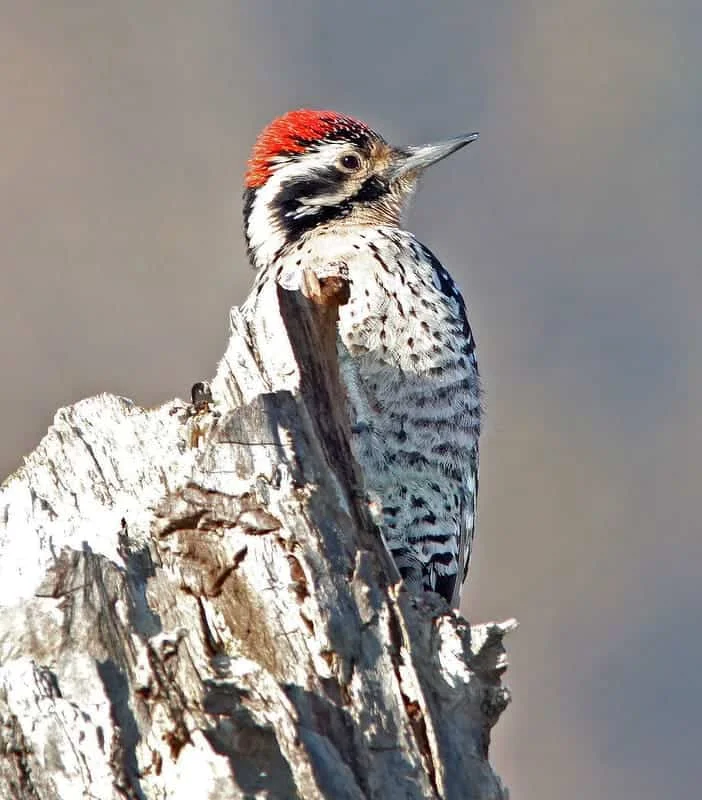
Wingspan
13 inches
Weight
0.7-1.7 oz
Life Expectancy
5 Years
Diet
Insects
A Ladder-Backed Woodpecker is a very small species of bird, identified by their black and white barring on their backs, their buffy wash, and their patterned flanks.
Similar to other woodpecker species, only the males have a red cap. Ladder-Backed Woodpeckers are known to take habitat in arid climates–especially dry woodlands.
They prefer deserts, desert scrub, and thorn forests. These woodpeckers tend to be inconspicuous and quiet, requiring skill, and patience to find.
However, you can tell when they are nearby when you hear their ‘peek’ sound.
Ladder-Backed Woodpeckers sometimes visit feeders and can be seen reforming their breeding pairs in winter and spring.
12. Red-Breasted Sapsucker
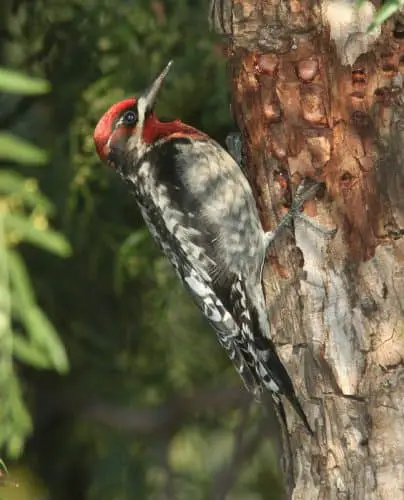
Wingspan
40cm
Weight
55g
Life Expectancy
2-3 Years
Diet
Insects
Red-Breasted Sapsuckers are medium-sized birds that display stunning plumage.
They have a red head and red breast with a striking white slash on the shoulder. Some birds have black and white patterns on their heads, though they have mostly black backs with little white detail.
Some Red-Breasted Sapsackers are winter visitors to Arizona, but they can primarily be seen in pine forests, with a mixture of deciduous trees like aspen, alder, and willow.
Their breeding season usually takes place in the middle of spring. Like most other woodpeckers, they nest in the cavities of their trees, though these sapsuckers do not always use the same cavity every year.
They are known for their harsh ‘waah’ call as well as their distinct, irregular drumming.
13. Gila Woodpecker
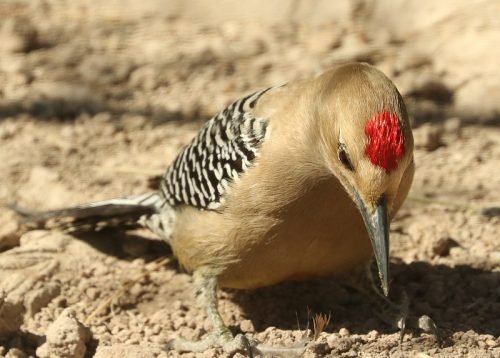
Wingspan
40cm
Weight
65g
Life Expectancy
10 Years
Diet
Insects
The Gila Woodpecker is a medium-sized bird almost exclusive to southern Arizona and western Mexico, found primarily in deserts with large trees or cacti.
These birds are grayish brown with brilliant black and white barring on their wings, tails, and backs. Only adult males, however, display red crowns.
Gila Woodpeckers are particularly noisy birds, tapping on a wide array of materials to attract a mate.
Gila Woodpeckers breed and nest in the cavities of the saguaro cactus. The inside of this cactus is a cool and safe place from heat and predators.
Though these woodpeckers are known to visit feeders in suburban areas, in Arizona, they can be seen in the Sonoran Desert, as they are permanent dwellers there.
14. Arizona Woodpecker
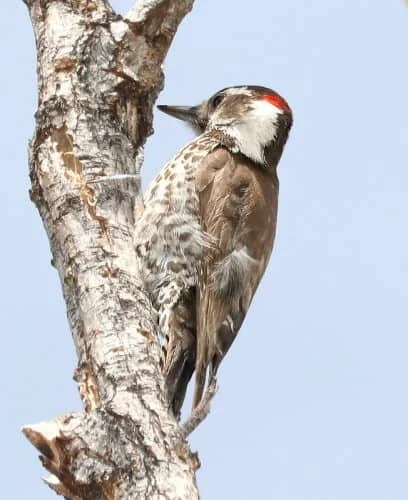
Wingspan
36cm
Weight
40g
Life Expectancy
10 Years
Diet
Insects
The Arizona woodpecker, as its name suggests, is a native to southern Arizona.
These birds are small and brown, with no white markings on its back, contrary to other species. Adult males display a tiny patch of red on the backs of their heads.
These birds also have a large white patch on their cheek and heavily spotted brown markings on their underparts.
In fact, the Arizona Woodpecker is the only United States woodpecker with these particular markings.
Arizona Woodpeckers nest and forage in pine-oak, oak, and sycamore-walnut woodlands.
These woodpeckers tend to begin making their nests in mid-winter. You can quite easily identify these birds by their sharp, high pitched ‘peek’ call or raspy jee-jee-jee sound.

More Articles.
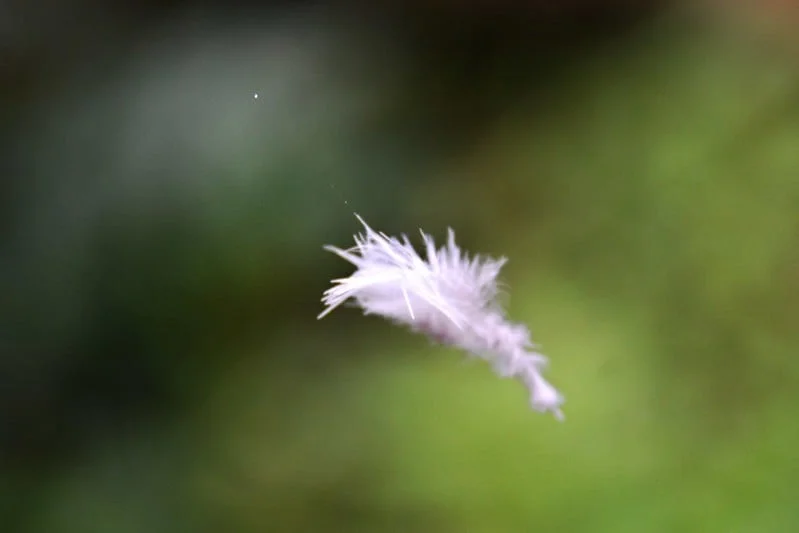
What Does It Mean To See a White Feather Fall in your Dreams? (Symbolism and Meaning)
In some cultures, seeing a white feather fall in your dream is a sign of
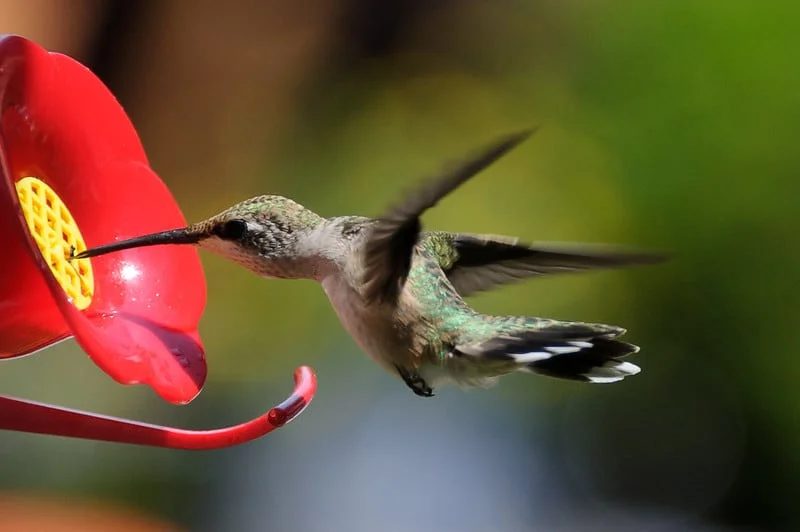
What time of day should you feed hummingbirds?
Hummingbirds are most known to prefer to visit a feeder and flowers as the sun
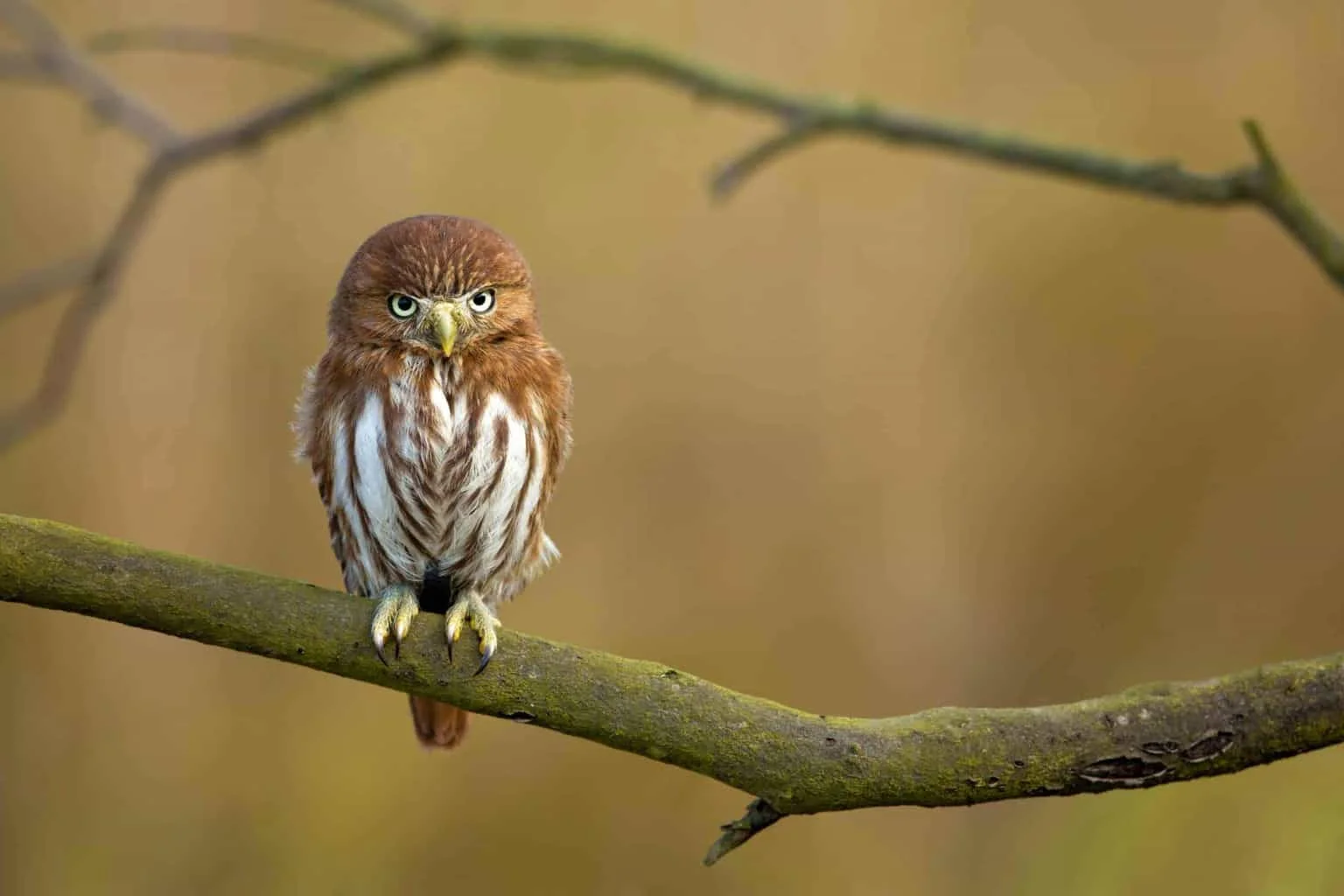
Owls are without a doubt one of the more interesting creatures around. These fearsome predators

About Us
We are avid bird-watchers who recently retired, allowing us more time to travel the world. Fortunately, we have managed to visit numerous countries around Europe, Asia, and America. Watching and photographing birds has been a passion for many years and we are making the most of the extra time on our hands!
